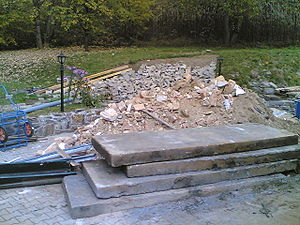| The examples and perspective in this article may not represent a worldwide view of the subject. You may improve this article, discuss the issue on the talk page, or create a new article, as appropriate. (December 2020) (Learn how and when to remove this message) |

Demolition waste is waste debris from destruction of buildings, roads, bridges, or other structures. Debris varies in composition, but the major components, by weight, in the US include concrete, wood products, asphalt shingles, brick and clay tile, steel, and drywall. There is the potential to recycle many elements of demolition waste.
Composition
In 2014, 505.1 million tons of demolition debris was generated in the US. Out of the 505.1 million tons, the debris was composed of 353.6 million tons of concrete, 76.6 million tons of asphalt concrete, 35.8 million tons of wood product, 12.7 million tons of asphalt shingles, 11.8 million tons of brick and clay tile, 10.3 million tons of drywall and plaster, and 4.3 million tons of steel.
Disposal
Before demolition debris is extracted, contamination from lead, asbestos or other hazardous materials must be resolved. Hazardous materials must be disposed of separately, according to federal regulation. Demolition debris can be disposed of in either Construction and Demolition Debris landfills or municipal solid waste landfills. Alternatively, debris may also be sorted and recycled. Sorting may happen as deconstruction on the demolition site, off-site at a sorting location, or at a Construction and Demolition recycling center. Once sorted, materials are managed separately and recycled accordingly.
Recycling
Concrete and Brick
Main article: Concrete recyclingConcrete and brick can be recycled by crushing it into rubble. Once sorted, screened and contaminants are removed, reclaimed concrete or brick can be used in concrete aggregate, fill, road base, or riprap. Mobile concrete crushers also allow for recycling of concrete on-site.
Wood
Main article: Timber recyclingWood can be reused, repurposed, recycled, or burned as bioenergy. Reused wood can eliminate the need for full-size new lumber if used for smaller building components. Repurposed or recycled wood can be used in pathways, coverings, mulches, compost, animal bedding, or particleboard. Using recycled wood as a bioenergy feedstock is advantageous because it has lower water content, about 20% water, compared to virgin lumber, about 60% water.
Drywall
Drywall is made primarily of gypsum. Once the gypsum is depapered, it can be added in cement production, as a soil amendment, used in aerated composting, or recycled into new drywall. Gypsum recycling can be particularly beneficial because in landfill conditions gypsum will release hydrogen sulfide, a toxic gas.
Asphalt
Asphalt, from shingles or asphalt concrete, is typically recycled and used in pavement.
Metal
Main article: ScrapScrap metal is an established industry focused on the collection, buying, selling, and recycling of salvaged materials.
See also
- Construction waste – Unwanted material produced directly or incidentally by the construction industries
- Recycling – Converting waste materials into new products
- Concrete recycling – Re-use of rubble from demolished concrete structures
- Waste management – Activities and actions required to manage waste from its source to its final disposal
- Control of Substances Hazardous to Health Regulations 2002 – United Kingdom health and safety legislation
- Embodied carbon – Measure of greenhouse gas emissions
- List of solid waste treatment technologies
- Index of waste management articles
References
- ^ "Sustainable Management of Construction and Demolition Materials". US EPA. 8 March 2016. Archived from the original on 26 April 2020. Retrieved 19 April 2018.
- ^ "Advancing Sustainable Materials Management: 2014 Fact SheetAssessing Trends in Material Generation, Recycling, Composting, Combustion with Energy Recovery and Landfilling in the United States" (PDF). United States Environmental Protection Agency. November 2016. Archived (PDF) from the original on 2019-10-10. Retrieved 2020-02-21.
- ^ "Harmful Materials and Residential Demolition". US EPA. 31 January 2013. Archived from the original on 19 April 2018. Retrieved 19 April 2018.
- ^ "Construction and Demolition Debris (C&DD)". epa.ohio.gov. Ohio EPA Division of Materials and Waste Management. Retrieved 19 April 2018.
- ^ . 7 February 2017 https://web.archive.org/web/20170207134250/https://www.colorado.gov/pacific/sites/default/files/HM_sw-beneficial-use-of-asphalt-brick-concrete.pdf. Archived from the original (PDF) on 2017-02-07. Retrieved 19 April 2018.
{{cite web}}: Missing or empty|title=(help) - "Recycling Wood Pallets and Packaging" (PDF). Timber Development Association (NSW). 2012. Archived from the original (PDF) on 2020-11-27. Retrieved 2020-02-21.
- "Scrap Metal Merchants Sector" (PDF). United States Environmental Protection Agency. 2016-09-20. Retrieved 2020-02-21.
